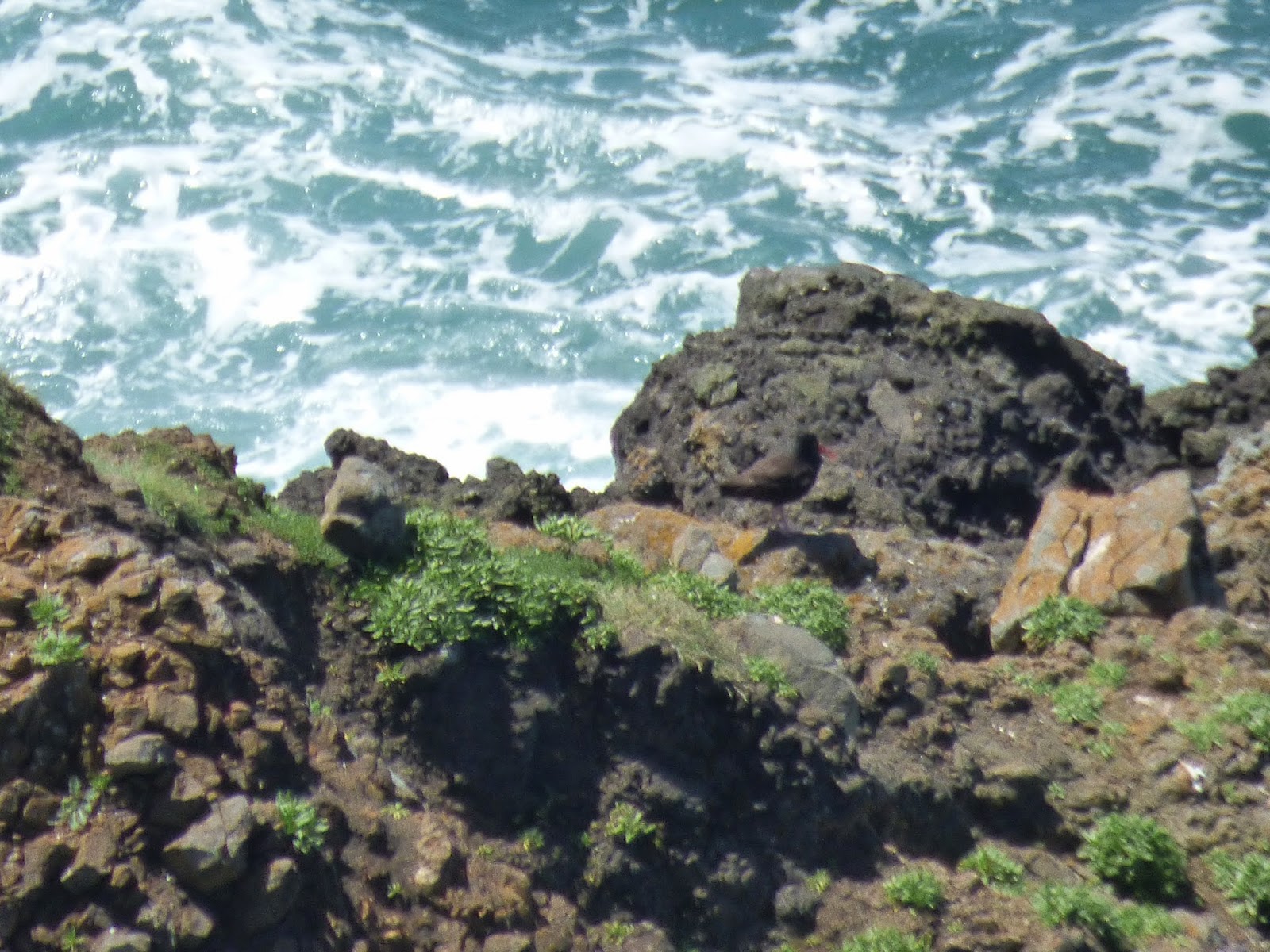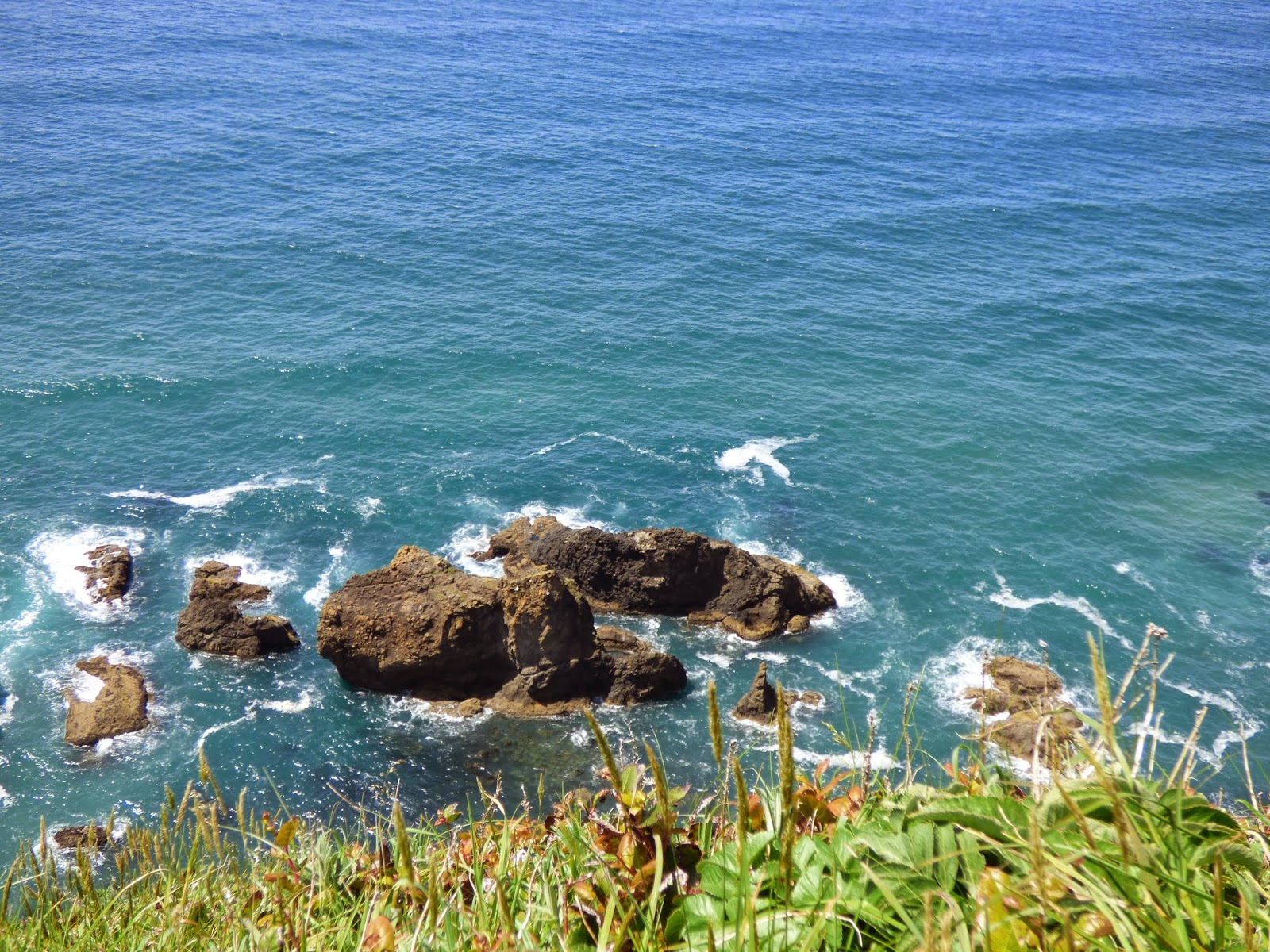We took a day off from planting the garden (me) tilling up the weedy chicken yard (Johnny), mowing (both of us), and many other farm projects, to do a Black Oystercatcher (BLOY) survey on the coast. It was predicted to be very hot at home so going to the coast seemed like a good idea.
Oftentimes when it's hot inland, it's foggy and cold near the ocean. But not yesterday. It was 80 degrees with no wind and no fog. Amazing weather.
Road's End was our survey site for our planned easy, restful day. We were first delivering some more of our old barn wood to friend Dawn in Lincoln City, who has been turning it into lovely bookcases and other woodworking projects and has promised to make one for me. Then it was lunch at our favorite Thai restaurant. And a beautiful hike up to the top of The Thumb at Road's End.
Almost as soon as we arrived, Johnny spotted one bird on the very distant North Nest Rock (our name). It's a great help that we now know where on which rocks the three pairs at Road's End like to nest. Without a good eye and a good spotting scope, this little black bird on North Nest Rock would be hard to detect.
Although we know exactly where on the south rock (that we call Original Nest Rock) the BLOY traditionally nest, we could not see a bird, although we could hear one calling from time to time.
But finally I spotted it. Black bird against black rock. Only the red bill gives it away.
Here it is zoomed up in the camera to blurriness.
We were so intent on searching for these black birds with red bills that we did not notice the pod of whales going by until a teen-aged girl came rushing down toward us from the top of the Thumb hollering "Do you see the whales?!" We had not. They were cruising right below us, just beyond our BLOY nesting rocks. Johnny counted 5 or 6 adults and at least 2 calves. The girl and her friend were from the Outdoor School at Camp Westwind, just north of this promontory where we survey BLOY. I'm very glad they alerted us!
Gray whales go south in the winter to calve in warmer waters and then back north in the spring. The cows with calves tend to stay close to shore to avoid deep water predators, or so I've been told.
After the whales passed, it was back to BLOY watching. We soon saw a single bird on the northwest pair of Middle Rocks. They nest on the southeast rock but the one not on a nest often stands guard on the nearby rock, where it can see the nest area.
Even though a BLOY is silhouetted against the surf in the photo below, it is very hard to pick out. When Johnny first spotted the bird, it was against those dark rocks.
Here it is zoomed up, right on top where they like to be. And where I like them to be so I can see them!
After we had watched nest exchanges on the Original Nest Rock and the Middle Nest Rock, and saw the North Nest Rock BLOY on guard duty, we packed up our gear and hiked back down. We had time for a mid-day snack in Pacific City and then a short side-trip to Cape Kiwanda.
We had seen a dead seal on the beach Sunday, during our BLOY survey there, which we thought was another Northern Elephant Seal, like we found on last month's COASST (beached bird) survey across the Salmon River. But we had taken no photos. We did that now and sent them to the beached mammal biologist at Oregon State who had identified the Northern Elephant Seal for us last month. He replied that it was a Stellar Sea Lion, probably long dead and decomposing before washing up on the beach. (The photos are too grisly to post here.)
It was still fairly early in the day, so we drove on to Cape Lookout to look for livelier creatures. We often see or hear BLOY there but have not yet located a nest. It is a very difficult area to survey because there is almost no visibility of the rocky habit Oystercatchers like. And it's a very long hike (nearly two and a half miles one way) on a path over tree roots to the tip of the cape. But it was a lovely day and I did not want to return home where it was almost certainly much hotter.
Here Johnny stops on one of the more civilized parts of the trail to admire the big trees.... or something. Or maybe he was just waiting for me to catch up.
My method for surviving long hikes is to stop often and take photos of flowers... and catch my breath.
 |
| False Lily of the Valley: Maianthemum dilatatum |
Half way out to the end of the cape is a view of a rocky outcropping that I've always thought should have a pair of BLOY on it, but never has. Until this day. Almost too far to pick out with binoculars (and we had not brought a scope on the hike with us), two tiny black birds with red bills were standing on the rock. My camera was able to see them better than we could.
And my photo program brought them even closer.
Then it was more hiking to the end of the Cape in hopes of hearing or seeing more BLOY there... or more whales. Fortunately, there were more flowers along the trail to provide a bit of respite.
 |
| Indian Paintbrush: Castilleja sp. |
What we saw all along the south side of the cape were huge and noisy rafts of Common Murres. There were thousands of them and their constant chatter sounded like angry cats fighting.
We neither heard nor saw BLOY at the end of the cape. No whales, either. But the view looking south toward Cape Kiwanda was lovely.
Zoomed up in the camera, the cape and the Rock looked much closer than they are!
The long walk back found more flowers, naturally.
 |
| Clasping Twisted Stalk: Streptopus amplexifolius |
 |
| Milkmaids: Cardamine californica var. integrifolia |
And then, just as the trail was about to enter the forest and leave the view of ocean, I spotted whales! While I tried rather unsuccessfully to get pictures of the whales so far below us, Johnny counted: 6 adults and 3 calves. We think it may have been the same pod we saw from Road's End, six hours earlier. This was the only smudge in the water more or less identifiable in my photos as a whale.
When we finally reached the trail head parking lot, we decided to drive the one mile farther to the only other place we have seen or heard BLOY at Cape Lookout. There are two large rock islands out in the ocean a long way and through many trees from this pull-out on the road, but with a scope we had seen BLOY there a few times in past years. We did not see any this time, as we peered through tree branches at rocks a very long way away, but we did hear one. By then it was 8:30 at night! So we headed home.
Our "easy, restful" plan to survey just at Roads' End had morphed into one whale of a day.























No comments:
Post a Comment